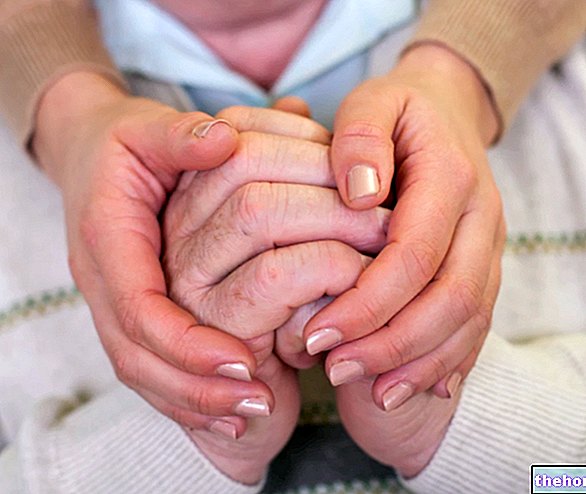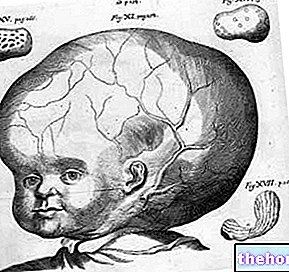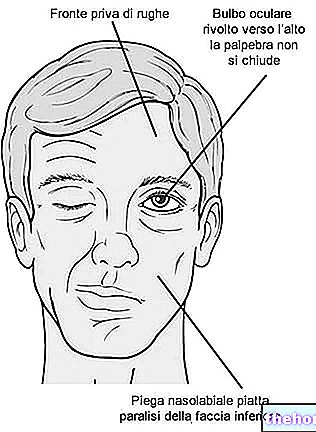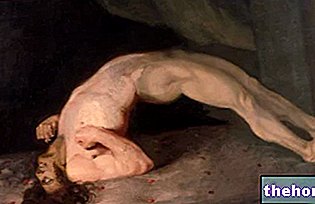Generality
The vegetative state is a possible evolution of the coma, corresponding to a waking condition, in which whoever falls into it is completely unaware of himself and of the surrounding environment.

At the origin of a vegetative state there can be: a severe trauma to the head, a severe episode of stroke or diffuse cerebral hypoxia, a severe metabolic disease, a neurodegenerative disease, a tumor or a brain abscess, a meningitis etc.
For a correct diagnosis of the vegetative state, the following are essential: physical examination, magnetic resonance of the brain, brain CT scan, brain PET scan and electroencephalogram (EEG).
Both due to the lack of specific treatments and the severity of the condition itself, the vegetative state generally has a poor prognosis.
What is the vegetative state?
The vegetative state is a waking condition that can follow a coma, characterized by unawareness of oneself and the surrounding environment.
Unfortunately, people in a vegetative state have little, if any, chance of returning to a normal life. In fact, in most cases, patients do not improve or show minimal improvements and are in constant need of assistance.
A quick definition of a vegetative state could have been the state of unconscious wakefulness.
VEGETATIVE STATE AND STATE OF MINIMUM CONSCIOUSNESS
The vegetative state represents an "alternative to the so-called state of minimal consciousness.
Briefly, the state of minimal consciousness is a waking condition that can occur in coma, in which the person concerned has a certain degree of awareness of himself and the surrounding environment.
EPIDEMIOLOGY
In Italy, according to some presumed estimates, the number of patients in a vegetative state and a state of minimal consciousness would be about 3,000-3,500. They are somewhat vague for at least a couple of reasons, which are: the lack of a reliable epidemiological study and the large number of misdiagnoses.
In the United States, the number of people in a vegetative state appears to be between 15,000 and 40,000. However, even in this case, these are rather rough estimates.
ORIGIN OF THE NAME
To propose the term "vegetative state" were the Scottish neurosurgeon Bryan Jannett and the American neurologist Fred Plum, in 1972.
OTHER NAMES OF THE VEGETATIVE STATE
In medicine, the terms “apallic syndrome” and “vigilant coma” are synonymous with the vegetative state.
Specifically, the wording "apallic syndrome" represents the original name of the condition that later B. Jannett and F. Plum called "vegetative state". It was coined by a German psychiatrist named Ernst Kretschmer in 1940. Kretschmer is known in the medical field because he has the merit of having first described the characteristics of the condition corresponding to the vegetative state.
Causes
To understand the transition from coma to vegetative state, it is necessary to summarize what determines the entry into a coma.
Coma occurs when the cerebral cortex and / or a structure of the brain stem called the reticular activation system (RAS) is damaged.
In fact, the cerebral cortex and RAS are the two nervous components (to be precise, the central nervous system) responsible for maintaining the state of consciousness.
Numerous neurological studies have shown that the transition from coma to vegetative state occurs in all those circumstances in which there is a functional recovery by the brainstem (specifically the reticular activation system), but not by the cerebral cortex.
EVENTS AT THE ORIGIN OF THE VEGETATIVE STATE
The vegetative state can result from episodes of coma following:
- Acute traumatic head injuries;
- Diffuse cerebral hypoxia;
- Neurodegenerative diseases;
- Severe congenital anomalies of the central nervous system;
- Severe metabolic diseases;
- Drug abuse / overdose intoxication, hard drugs, harmful substances or alcohol;
- Meningitis;
- Stroke;
- Brain hernia;
- Brain tumors or abscesses
- Advanced hepatic encephalopathy;
- Severe epilepsy;
- Acute disseminated encephalomyelitis (ADEM).
TYPES
The community of neurologists and the Royal College of Physicians they believe it is correct to distinguish the vegetative state on the basis of the temporal duration. This results in two main types of vegetative state: the continuous vegetative state and the permanent vegetative state.
- The vegetative state that has been in progress for more than 4 weeks but for less than 6 months is defined as continuous.
- On the other hand, the vegetative state in progress for more than 6 months, if the cause is non-traumatic, and for more than 12 months, if the cause is traumatic, is defined as permanent.
Symptoms, signs and complications
The characteristic symptom of the vegetative state is the lack of awareness of oneself and of the surrounding environment.
To this are added: the inability to respond to visual stimuli or voice commands, the inability to make voluntary movements, the inability to interact with other people, fecal incontinence, urinary incontinence and the absence of a behavioral response.
FUNCTIONS AND ABILITIES PRESENT IN PEOPLE IN A VEGETATIVE STATE
People in a vegetative state can recover functions and abilities, which are typically absent in a coma.
Unlike those in a coma, in fact, those in a vegetative state:
- It has both regular and correct cardiac function and respiratory function;
- He has complex reflexes, which allow him to yawn, chew, swallow etc;
- He is able to temporarily open and move his eyes;
- It is able to hear the loudest noises;
- Reacts with involuntary movements, as a result of painful stimuli;
- It has a sleep-wake cycle. It is important to point out that the sleep-wake cycle of people in a vegetative state is often anomalous;
- May smile or frown;
- He has spinal reflexes.
Diagnosis
The vegetative state alters consciousness in a similar way to other conditions.This could, consequently, make its identification complex and require the execution of various diagnostic tests.
Among the tests useful for a correct diagnosis of the vegetative state, certainly deserve a mention: the physical examination, the magnetic resonance of the brain, the brain CT scan, the brain PET and the electroencephalogram (EEG).
OBJECTIVE EXAMINATION AND CLINICAL CRITERIA
The objective examination allows to establish the presence or not of those clinical criteria necessary to affirm whether a person is in a vegetative state or not.
According to these clinical criteria, a person is in a vegetative state if:
- When awake, his eyes are open and shows some ocular and eyelid mobility; in spite of this, however, he does not follow any visual stimulus with his gaze;
- He has no awareness of himself and of the surrounding environment;
- Presents the sleep-wake cycle;
- Shows reflex patterns of involuntary movement, in response to painful stimuli;
- Performs stereotyped spontaneous movements;
- May have complex reflexes, including chewing and swallowing movements, facial grimacing, yawning and hand grasping;
- Breathe autonomously;
- Has a normal heart rhythm.
Therapy
Doctors and experts in the field of vegetative state, state of minimal consciousness and coma have not yet identified a medicine or a particular therapeutic instrument capable of restoring a normal state of consciousness in the person concerned.
Having said this, for those in a vegetative state, supportive therapy is provided, which includes:
- All those precautions aimed at preventing complications from immobilization.
The main complications of immobilization include: aspiration pneumonia, bedsores and thromboembolic disease; - The administration of food and water in the correct quantities and methods (correct and complete nutrition). Providing the affected organism with all the necessary nutrients is essential for survival and maintenance of a good state of health;
- Physiotherapy exercises, to prevent muscle contractures due to prolonged immobility.
Supportive therapy is essential to keep the patient alive and significantly reduce the risk of complications (eg: the aforementioned bedsores, aspiration pneumonia, etc.).
Prognosis
Generally, the vegetative state has a poor prognosis, in the sense that affected patients tend to never fully recover, even after regaining a certain degree of self-awareness and the surrounding environment.
The outcome of the vegetative state is usually the permanence in this condition or death.
That said, there are several factors that influence prognosis; among the factors in question, they certainly deserve a particular mention:
- The triggering causes and extent of brain damage. It is known that there are greater hopes of recovering from a vegetative state, when the latter depends on a reversible condition (for example a metabolic disease) or on limited brain damage, rather than on a stroke not treated in time or extensive brain damage.
- The patient's health condition before entering a coma. An individual with poor health even before entering a coma (and in a vegetative state) is much less likely to wake up and return to a normal life.
- The age of the patient. According to various surveys, the patients who recover best from a vegetative state are patients of a young age, while the elderly, on the other hand, have little hope of recovery.
CURIOSITY
Statistical studies have shown that a protracted vegetative state coincides with little chance of recovery and a "high probability of death. In other words, people in a vegetative state for a long time (months or even years) have little hope of becoming aware again. and to survive further.
Generally, subjects in a vegetative state die from aspiration pneumonia or from "multiple organic insufficiency."
According to some surveys, the percentage of individuals in a vegetative state that survives for more than 5 years is equal to 25% of patients.
Patient sample and origin of the vegetative state
One year after the triggering episode
Sample of patients who entered a vegetative state one month after a causal event of a traumatic type
- 54% of the subjects concerned had regained some degree of awareness of themselves and of the surrounding environment;
- 28% of those affected had died;
- 18% of the subjects concerned were still in a vegetative state.
Sample of patients who entered a vegetative state one month after a non-traumatic causal event (e.g. stroke)
- 14% of the subjects concerned had regained a certain degree of awareness of themselves and of the surrounding environment;
- 47% of those affected had died;
- 39% of the subjects concerned were still in a vegetative state.




























